The Papenburg yard of Jos. L. Meyer was established on the river Ems in 1795, and the family owned yard have been building all types of ships for over two hundred years with the sixth generation of the family now in charge. Iron ships were built from 1872 and steel ships ten years later, and the first ro-ro ferry took to the water named Malmo in 1964. The first large cruise ship, Homeric of 42,000 grt, was spectacularly launched sideways on 28th September 1985, and when her fitting out was complete, she faced a two day slow tow through narrow locks to reach the sea at Emden. Currently, the yard are building ‘mega’ cruise ships, passenger and car ferries, ro-ros, gas tankers and livestock carriers.
Nine memorable sister ferries were built during 1970/75 at the Papenburg yard of Jos. L. Meyer, with six for Viking Line of Finland, and three for the Mexican Government. The original Viking Line of Mariehamn in the Aland Islands was set up in 1959, jointly by Gunnar Eklund and Henning Rundberg, both Finnish Master Mariners that had previously served together on the famous four masted barque Pamir. The Southampton to Channel Islands twin screw ferry Dinard of 2,291 grt, dating from 1924 and powered by four steam turbines when completed by the Denny yard at Dumbarton, was purchased for £30,000 and sent to Aalborg for conversion into a car ferry. She was fitted with a stern ramp and painted with a light blue hull and two yellow funnels with black tops, and renamed Viking with Henning Rundberg as manager. In June 1959, she began her daily summer route from Kapellskar in Sweden to Mariehamn and Parainen in Finland, with a twice daily service on Sundays from Kapellskar to Mariehamn.
Kapellskar is a tiny hamlet forty miles north east from Stockholm, whose sole raison d’etre for existence is the now large Viking Line ferry terminal, with a free connecting bus service from Kapellskar into the centre of Stockholm. Ferries have to reverse out of a narrow inlet when leaving for Finland, and a poignant memorial was later placed on a hillside above Kapellskar to commemorate the 852 lives that were lost in January 1994 in the dreadful Estonia ferry disaster in the middle of the Baltic. Estonia was completed at Papenburg in 1980 as Viking Sally of 15,566 grt for Viking Line, and had sailed from Tallinn on her last fateful voyage to Stockholm with five hundred returning Swedish shoppers and three hundred passengers of Estonian nationality, but a severe storm forced open her bow shield and only a handful of strong swimmers survived the freezing winter Baltic waves.
Mariehamn is a charming little town and home to Viking Line, reached by a two hour voyage from Kapellskar. The voyage time is three hours from Mariehamn to Naantali, which is also a small town with a connecting bus service to the larger city of Turku in Finland. It is very worthwhile staying overnight in Mariehamn and then continuing the next day to Naantali. Mariehamn was founded in 1861 by Tsar Alexander II as his summer retreat and was named after his wife Maria. Scenic roads and beautiful countryside takes one to Badhausberget with panoramic views over the whole archipelago. The former giant Wartsila yard at Turku is coincidentally now owned jointly by Jos. L. Meyer and the Finnish Government, this consortium having taken over the STX Finland owned yard on 4th August 2014.
A disagreement had arisen by 1962 between the partners Gunnar Eklund and Henning Rundberg as to the way forward. Henning Rundberg preferred tramp and tanker shipping to the new car ferry business, as he already owned the former Klaveness tramp Castleville of 9,000 dwt and built by the Framnaes yard at Sandefjord in 1945, as well as the tanker Linden of 15,680 dwt built by the Scotts yard at Greenock in 1951 as LInde. Gunnar Eklund then formed another ferry company, Alandsfarjan A/B, and purchased another elderly Channel Islands ferry, this time it was Brittany of 1,445 grt built by the Denny yard in 1933 for the Jersey to France service. She was purchased on 21st April 1963 and converted with a stern ramp and a new large saloon under the bridge of the width of the vessel for passengers from Mariehamn to Graddo near Turku in Finland and from Mariehamn to Herrang in Sweden. She was renamed Alandsfarjan and began her service on 20th June 1963 from Mariehamn to Graddo.
Steam turbine powered British passenger ferries such as Dinard and Brittany used shore cranes to lift a few cars on and off during the 1950s, and were of a simple design compared to the nine motor ferries that are the subject of this article. The pair had three decks, comprising the Promenade Deck with the First Class Lounge extending fore and aft and the mail room and baggage room aft, Main Deck had the First Class cabins and restaurant forward, with Second Class Lounge and the crew accommodated aft, while Lower Deck had the Second Class Saloons, not cabins, aft for their accommodation, with separate saloons for ladies and gentlemen. They usually had good service speeds of between fifteen and eighteen knots for their Channel services.
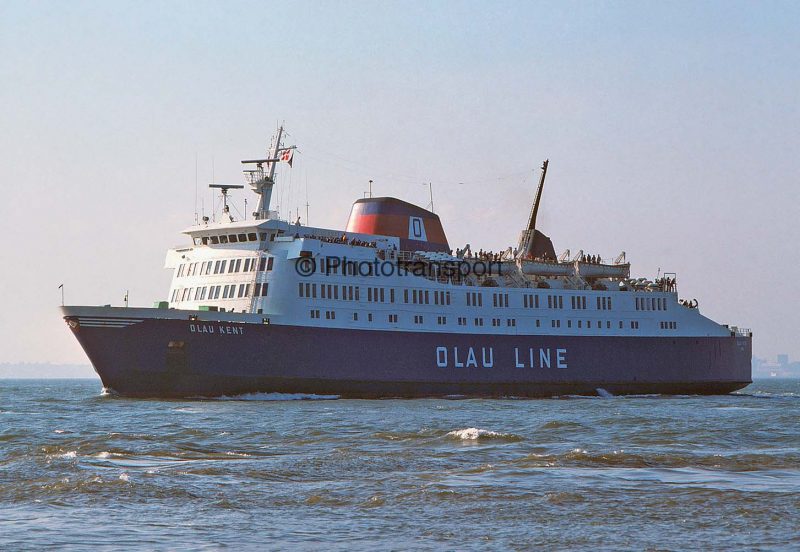
In 1966, Viking Line was reorganised as a marketing company by Alang shipowner Stig Lundquist for three ferry operators of Rederi A/B Sally (Algo Johansson), Rederi A/B Slite (Carl Bertil Myrsten) and S-F Line (Gunnar Eklund). The ‘old’ Viking Line was renamed Rederi A/B Sally, and Alandsfarjan A/B was renamed S-F Line, with Rederi A/B Slite also dating from 1959. The joint timetables and tickets were issued for these three separate companies of the consortium, and it was so successful that Viking Line had ordered six of the nine Papenburg sister ferries for delivery between 1970 and 1974, and owned ten large Baltic ferries in 1990.
These had included:-
Aurella (8,100 grt, 1,200 passengers), Kapella (3,159 grt, 1,200 passengers), Marella (3,930 grt, 1,200 passengers), Turella (10,604 grt, 1,700 passengers), Rosella (10,757 grt, 1,700 passengers), Mariella (37,800 grt, 2,500 passengers), Olympia (37,800 grt, 2,500 passengers, and sisters Viking Saga and Viking Sally (both 15,000 grt, 2,000 passengers).
The Mexican Government subsidiary of Transbordadores S.A. ordered three more sisters for delivery between 1973 and 1975 for services across the sea from Baja California to the mainland of Mexico. These were from Mazatlan to La Paz on the peninsula, and from Puerto Vallarta to Cabo San Lucas, and from Santa Rosalia to Guaymas. The trio were registered under Caminos y Puentes Federales de Ingresos y Servicios Conexos (Highways, Bridges and Connecting Services). They joined other similar ferries already in operation to Baja California in Akershus 5,117/65, La Paz 2,531/64, Presidente Diaz Ordaz 2,914/61, and Jasmine 1,966/74.
SPECIFICATION of the PAPENBURG SISTERS
The basic specification was for a modern stylish motor ferry with three passenger decks for 222 berthed passengers, 1,200 deck passengers, with one ‘drive through’ car deck for 260 cars and 26 lorries to be handled through both bow and stern doors. The ferry was to have a fast service speed of nineteen knots powered by twin single acting twelve cylinder Klockner- Humboldt-Deutz diesel engines of 8,000 bhp driving variable pitch KaMeWa propellers and equipped with a forward thruster for manoeuvrability at restricted ferry terminals. They were ice strengthened, had three auxiliary generators, an overall length of 356.8 feet, moulded beam of 56.7 feet and a depth to car deck of 19.8 feet, a draft of 15.1 feet, with a gross tonnage of around 4,250. They were given the names of Apollo, Viking 1, Viking 3, Diana, Viking 4 and Viking 5, with Apollo and Diana registered under R/A Slite, and the other quartet registered under R/A Sally.
The sisters had three passenger decks named Boat Deck, Restaurant Deck and Cabin Deck, and one car deck. There were six lifeboats on Boat Deck with two more motor lifeboats on the navigating bridge deck above, which also had the wheelhouse, chartroom, radio room, radio operator, Master’s suite, and the top of the ventilation plant inside the funnel. There were plenty of liferafts on the open deck space of Boat Deck, whose main feature was the large forward looking lounge and bar for 160 passengers with panoramic views. There were 54 aircraft type seats aft of the stair well, and the emergency generator and ventilation plant were arranged around the funnel casing on Boat Deck. Restaurant Deck had a large forward looking Dining Room for 145 passengers, and working aft there was a saloon to port for 32 passengers and the hot and cold galleys to starboard, and then the large self-service cafeteria for 226 passengers with another 42 aircraft type seats arranged around the funnel casing. Cabin Deck had cabins for 222 passengers, with a large supermarket and shop ‘midships just in front of the main entrance hall.
Viking 5 was longer than her sisters by nine metres to accommodate 285 cars on the Car Deck, and she had a longer Boat Deck and Cabin Deck. The reason why there was no Viking 2 in the series of names of the sisters was that this name was given to a smaller ferry built in 1940 by Aalborg Verft as Marsk Stig for the Grena to Hundested route, and purchased in 1967 by R/A Sally. She had accommodation for 700 passengers and was a stern loader for 65 cars and seven lorries. She had a service speed of sixteen knots from a B & W diesel engine of 4,200 bhp, but she suffered a bad fire in 1978 and was broken up a year later.
When Viking 5 entered service on the Helsinki to Stockholm route on 9th July 1974, arrangements were quickly made for a similar ferry to be purchased from the Alaska Marine Highway System as Wickersham to partner her on this route. This purchased ferry was renamed Viking 6 of 6,942 grt, and had been built by a yard at Langesund and fitted out at the Framnaes yard in 1967 as Stena Britannica with accommodation for 1,170 passengers and 220 cars, and was equipped with bow and stern doors. She had streamlined aft superstructure and a swept back funnel, and a good service speed of eighteen knots from twin 16-cylinder M.A.N. diesels. After Viking Line service and two spells of charter work to Brittany Ferries and Sol Line of Cyprus, she was sold in 1986 to NavArMa (Moby Lines) of Italy and renamed Moby Dream and was still in service in 2002.
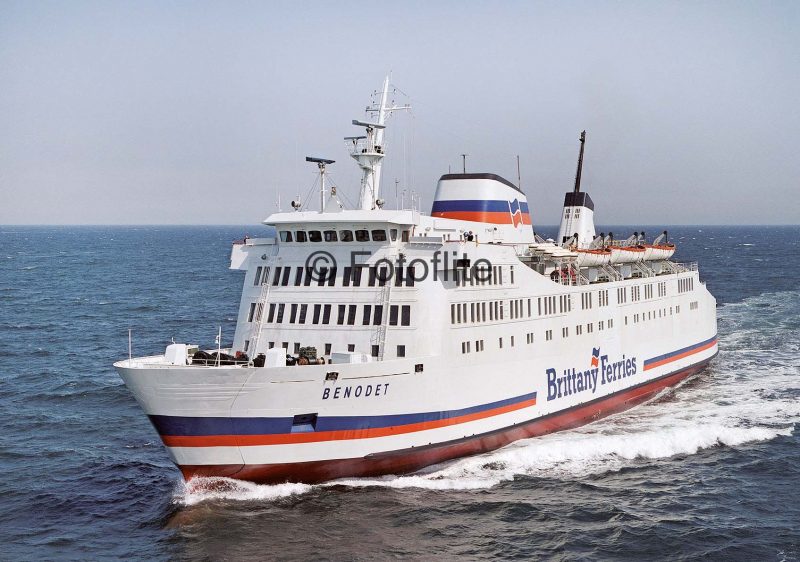
Viking Line was very successful during the 1970s, with ticket sales growing rapidly and thus new larger ferries had to be purchased or ordered from shipyards. The Baltic service of Apollo, Viking 1, Diana, Viking 3, Viking 4 and Viking 5 was thus relatively short, some as short as only four years. The careers of these six stylish modern ferries will now be given.
APOLLO
Apollo entered service on 2nd May 1970 on the Kapellskar to Mariehamn and Naantali route, and six years later was sold on 12th March 1976 to Ole Lauritzen for his new Sheerness to Vlissingen ferry venture. Apollo was renamed Olau Kent and she was in service on this route from April 1976 until she was arrested on 10th September 1980 for non payment of a ship chandler’s bill. The ferry was sold at auction on 5th November 1980 to Nordisk Faergefart for the route between Gelting in Germany and Faaborg in Denmark. She was renamed Gelting Nord and operated on this route from March 1981 until May 1982 when she was re-engined with twin more powerful M.A.N. diesels and transferred to Skagerrak service from Hundested in Denmark to Sandefjord in Norway.
A charter was then secured from Brittany Ferries in March 1984 for the Plymouth to Roscoff service in the Western English Channel and she was renamed Benodet after a well known resort near Quimper in Brittany. She was then taken on a Channel Island Ferries charter, with Brittany Ferries owning 30% of Channel Island Ferries at that time. Apollo now took the name of Corbiere after the famous lighthouse of the same name on the north west tip of Jersey, and began her Portsmouth to St. Helier service on 28th March 1985. After four years service from Portsmouth, later under British Channel Island Ferries, she transferred to Poole to Channel Islands service for a Truckline charter lasting until the end of 1990. Apollo returned to the Baltic in the Spring of 1991 after being sold to Eckero Line and served Estonian New Line as Linda 1 until 1994, when she operated with Tallink of Estonia as Corbiere, before joining Eestin Linjat under her original name of Apollo.
Apollo was then sold in 1999 to Labrador Marine Inc. of St. John’s (NFL) and entered service in May 2000 on the St. Barbe (Newfoundland) to Blanc Sablon (Labrador) route for the Woodward Group of Canada. She was still in service on this route at the time of writing under her original name of Apollo.

VIKING 1
On 13th August 1970, Viking 1 entered service on the Kapellskar to Mariehamn and Naantali route, with her number of cabin berths increased in 1975 from 222 to 310 by extending the Cabin Deck further aft. As she could now cope with higher passenger numbers, she made several crossings on the main Stockholm to Helsinki route of Viking Line as well as serving on the route for which she was built. A one month charter was obtained in April 1982 from Brittany Ferries when one of their own faster ferries was out of commission for repairs, but even the nineteen knot service speed of Viking 1 was at times not fast enough for the Portsmouth to St. Malo timetable and she occasionally ran late. She returned in May 1982 to her familiar Kapellskar to Mariehamn and Naantali route until the end of the summer season on 31st August 1982, when she was laid up. She then moved further north up the Gulf of Bothnia to the Vaasa to Umea route for the 1983 season, as R/A Sally had purchased Vassanlaivat O/y of Finland on 1st September 1982. This company is marketed in Sweden as Vasabatarna A/B, with ‘Vassanlaivat’ appearing on the starboard side of the hull of their ferries, and ‘Vasabatarna’ on the port side. She was renamed Wasa Express for the 1983 summer season, but regained her name of Viking 1 for the 1984 summer season until she was chartered on 20th June 1984 for service on the Red Sea from Suez to Jeddah under the name of Khalid 1, with an option to purchase.
The former Viking 1 was given a thorough refit at Bremerhaven before sailing for the Suez Canal and the Red Sea on 17th July 1984. The option to purchase the ship was taken up in 1985 and the ferry was renamed Mecca 1. A bad fire in her engine room while berthed at Suez on 3rd August 1985 caused multiple problems with water damage due to fire fighting, and three cabins completely destroyed on Cabin Deck. She was able to carry on her service after temporary repairs were made, and she was eventually fully repaired. She was renamed Al Hussein II in 1986 until 1991, Al Qamar Al Saudi Al Misri during 1991/92, Mecca I during 1992/93, Al Qamar Al Saudi II during 1993/94, regaining the name of Mecca I during 1994/99, while maintaining all the while her Egypt to Saudi Arabia trade. She was renamed Fagr of Fouda Line in 1999 to continue the same service, but she capsized on her port side in port during 2000 and was raised and broken up two years later.
VIKING 3
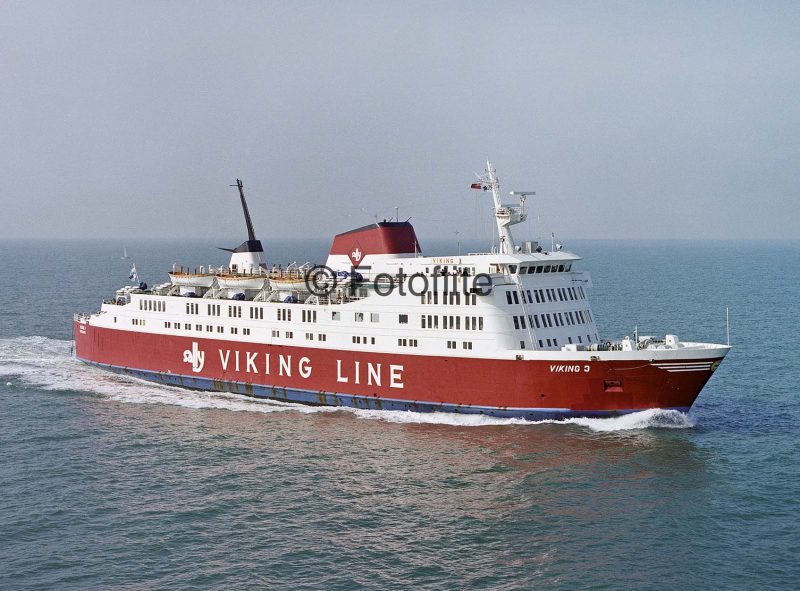
Viking 3 entered service on 16th April 1972 on the Kapellskar to Mariehamn and Naantali route, and served for four years until sold on 4th May 1976 for service further north up the Gulf of Bothnia from Vaasa (Finland) to Umea (Sweden) under the name of Wasa Express. The purchasers were a Finnish company that was renamed Vaasanlaivat O/y in 1979, but Viking 3 came back into the consortium of Viking Line on 1st September 1982 when Sally R/A purchased Vaasanlaivat O/y. The Vaasa to Umea service continued until March 1983 when she was used on the Ramsgate to Dunkirk service of Sally Line, a new service begun by her sister Viking 5 as The Viking from 10th June 1981. Viking 5 then returned to the Baltic, with Viking 3 returning in the 1984 season to her Vaasa to Umea route as Wasa Express.
Viking 3 was sold in 1988 to Eckero Line and renamed Roslagen for the Eckero (Aland Islands) to Grisslehamn (Sweden) route. She later had stability sponsons fitted aft to continue her Aland Islands service until 2007, when she sold to Agoudimos Lines of Piraeus and renamed Ionian Spirit. She joined the other Agoudimos Lines ferries on Ionian Sea and Greek domestic routes and served until she was laid up at Brindisi in October 2015. In October 2016 she was acquired by Seamed Tarding of Brindisi and renamed St Damian.
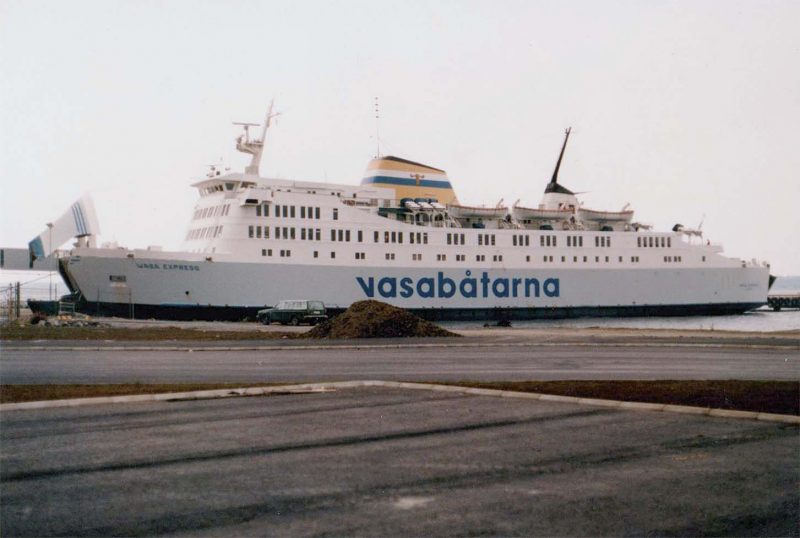
DIANA
Diana entered service on the Kapellskar to Mariehamn and Naantali service on 17th December 1972, serving until sold on 24th April 1979 to Vaasanlaivat O/y. She was renamed Botnia Express for the services from Vaasa (Finland) to Umea and Sundsvall in Sweden, but rejoined the holding consortium of Viking Line on 1st September 1982 when R/A Sally purchased Vaasanlaivat O/y. The Restaurant and Boat Decks had been extended by eight metres in 1980 to improve her cafe and restaurant facilities. In severe winter weather, Vaasanlaivat O/y ferries can become wedged in by solid ice in the Gulf of Bothnia, the normal voyage in summer takes only three and one half hours. Diana was sold in 1992 to Eckero Line of the Aland Islands and renamed Alandia for services from the islands to Sweden, which continued for fourteen years until she sailed to Jeddah for new owners in 2006. She was renamed Jamaa II by the Skarfia Shipping Company, and is still in service between Egypt and Saudi Arabia.
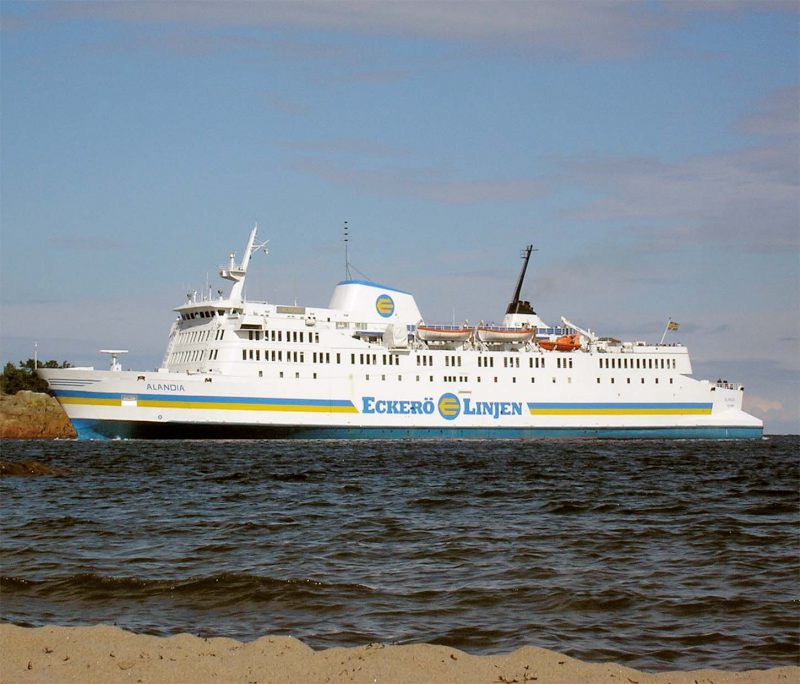
VIKING 4
Viking 4 began service on the direct Stockholm to Mariehamn and Turku route on 16th June 1973, with her Cabin Deck extended aft to the stern to give more cabin berths for 374 berthed passengers and 826 deck passengers, and her Car Deck was capable of taking three hundred cars. She continued on this service for seven years until sent back to her builders at Papenburg in April 1980 for an extensive refit to bring her up to Department of Trade specification before beginning a charter to Sealink for services from Portsmouth to the Channel Islands under the name of Earl Granville. She was re-engined with twin 12-cylinder Crossley Pielstick diesel engines of 5,800 bhp at 482 rpm to give 11,600 bhp, and fitted with Denny Brown stabilisers. The cabins were reduced in number to take only 195 berthed passengers although her total complement of passengers remained at 1,200. After acceptance trials and delivery from the shipyard, she was sold in March 1981 to Williams and Glynns Industrial Leasing Ltd. for £10.5 million and demise chartered to Sealink.
Earl Granville made her first crossing on 21st March 1981 from Portsmouth to the Channel Islands, but three months later on 22nd June with 377 passengers on board she suffered a fire in the engine room fifteen miles out from Portsmouth. The crew extinguished the blaze and the ferry was towed back to Portsmouth, with repairs undertaken at the Husband’s yard at Southampton. In the summer of 1983, she made extra sailings from Weymouth to the Channel Islands, and in the following summer season she was placed on the luxury ‘Starliner’ run to the Channel Islands. On 30th September 1986, she was transferred to the new British Channel Island ferries combine, and began twice daily Portsmouth to Channel Islands services along with her sister Corbiere, the former Apollo. She struck rocks on 19th August 1989 when entering Cherbourg harbour, badly gashing her hull, when the procedures to call her Master to the navigating bridge in proper time had failed. She was repaired at Le Havre over the next month, but failed to come up to the new stability standards set after the Spirit of Free Enterprise disaster off Zeebrugge. She was given three years of grace to come up to the standards, and was sold before this deadline on 12th December 1990 to Agapitos Lines of Greece and renamed Express Olympia. She was refitted before entering Agapitos Lines service in the Aegean, with her stern altered and a covered area added aft on Boat Deck to give protection from the wind and sun. She was given an all white hull and a blue ‘A’ to her white ‘midships’ funnel, and a blue top to her aft exhaust structure. She later came under the ownership of Minoan Flying Dolphins, and was sold in August 2005 to breakers at Alang in India and made her last voyage as Express O.

VIKING 5
This ferry of 5,286 grt was by far the best of the six near sisters, with a longer hull to give her better capacity for the overnight Stockholm to Helsinki main Viking Line route. She had a longer ‘midships funnel to make her the most handsome of the class, and began her service on 9th July 1974. During the summer season of 1980, she was also used on the Stockholm to Turku, and Kapellskar to Mariehamn and Naantali routes. She was renamed The Viking for the new Viking Line venture into British waters from Ramsgate to Dunkirk in June 1981, and moored in the Pool of London to show the British travel press the new ‘Viking’ invader. She suffered an engine room explosion on 10th August 1981 en route to Ramsgate, and she was out of service for the rest of the season and over the winter of 1981/82 as she was re-engined with twin 12-cylinder Klockner-Humboldt-Deutz diesels of 6,600 bhp. Viking 5 served for two summer seasons on the English Channel and returned to the Baltic in April 1983, to begin preparations for services between Vaasa and Sundsvall in Sweden as Sally Express for Vaasanlaivat O/y. After one year on this Gulf of Bothnia service, she was sold to Fred. Olsen Lines on 15th March 1984 and renamed Bolette for ‘Skagerrak Express’ services.
Bolette returned to Papenburg for a major overhaul and gained two extra lifeboats and an extension to her Boat Deck to begin her Hirtshals and Hantsholm in Denmark to Kristiansand service in May 1984. She ran on the very regular five hour ‘Skaggerak Express’ services for five summer months of both 1984 and 1985, and was laid up in winter at Kristiansand. After short charters and use as a hotel ship during the winter of 1985/86, she returned to her summer services on the Skaggerak until a most interesting charter was obtained in October 1986. This was for use as an accommodation ship at Reykjavik in connection with the talks between President Ronald Reagan and President Mikhail Gorbachev of the Soviet Union. She undertook this charter for only one week in October 1986, after which she returned to lay up in Kristiansand.
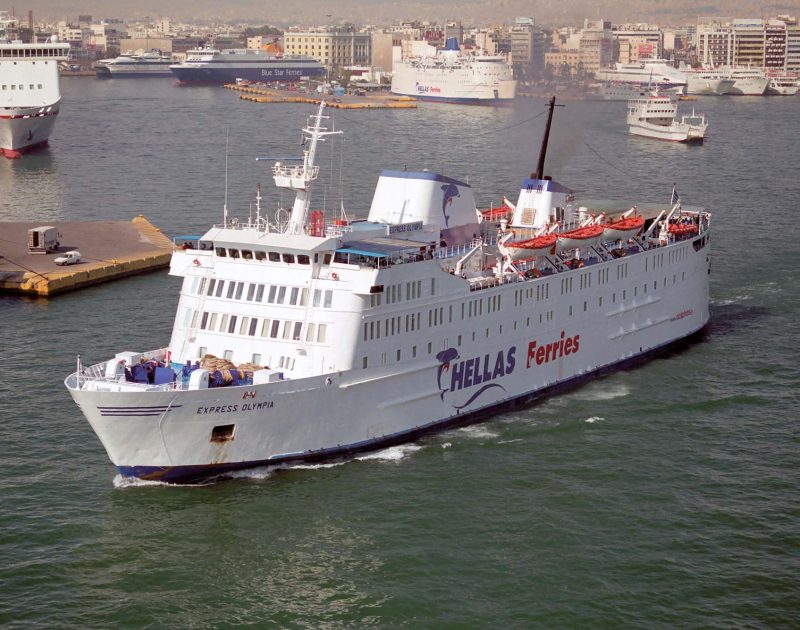
THE MEXICAN TRIO
This trio of Coromuel, Puerto Vallarta and Azteca ran with white hulls and red funnels on the Mexican Government services from the mainland of Western Mexico to the peninsula of Baja California. The trio were fitted with stabilisers by the Meyer yard at Papenburg as their routes were across part of the wild and stormy Pacific Ocean. These were from Mazatlan to La Paz on the peninsula and run by the ferry Coromuel, and from Puerto Vallarta to Cabo San Lucas run by the ferry Puerto Vallarta, and from Santa Rosalia to Guaymas by the ferry Azteca. The trio were fitted with an enclosed extension at the aft end of Boat Deck, and this and other internal differences for 182 berthed passengers and 1,200 deck passengers increased their gross tonnage to around 6,800 to 7,000.
The trio changed their funnels from red to blue in 1989 when the Mexican Government Transbordadores S.A. subsidiary was renamed as the State owned Sematur Ferries S.A., but the latter company went out of business in 2004. The ferry services were sold on to Baja Ferries S.A. with Coromuel renamed as Sinaloa Star, and Azteca sold in April 2004 to United Arab Emirates (UAE) interests and renamed Ajman 1 but she was quickly sent to Bangladeshi breakers and arrived at Chittagong on 28th September 2004 for scrapping. Sinaloa Star crossed the Pacific to the picturesque Halong Bay in Northern Vietnam to carry out a cruise season in 2007 among the craggy islands of the Bay under the name of Chu Lai. These were her last voyages as she arrived for scrapping at Alang in India on 18th September 2008.
Puerto Vallarta was the best of these three ferries, and had smaller windows on her Boat Deck than her two sisters. She suffered a bad fire while laid up at Mazatlan on 9th October 2008 with smoke pouring out of the ship ‘midships. She is still in existence but currently laid up.
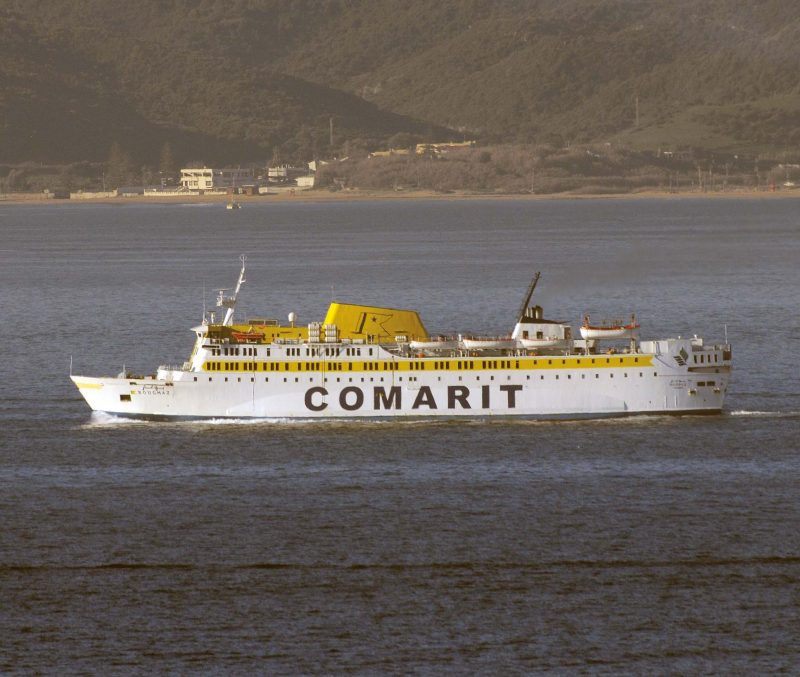
POSTSCRIPT
I was fortunate to see three of these nine ferries during their very long careers in many varied parts of the world. They served in the Baltic, Skagerrak, British waters, Iceland, the Mediterranean and the Red Sea, as well as the Mexican coasts and Pacific for the Mexican Government trio. Earl Granville ex Viking 4, and Corbiere ex Apollo were seen on the south coast of England on their various charters and sale options from Viking Line, and Bolette ex Viking 5 was seen on her Skagerrak services as well as several times in Algeciras and Tangiers as Boughaz of Comarit. The harbour at Tangier was always full of colourful ferries disgorging large numbers of passengers who had to normally walk some distance to the exit at the ferry terminal. The Algeciras ferry terminals were easier to reach at the town end of the long Maersk Line quay for mega container ships, and quite handy from the Reina Cristina Hotel where I stayed.
Viking Line today operate seven large ferries of up to 57,000 grt on the same network as their former sextet of Papenburg built sisters operated. The ferries are Gabriella of 35,154 grt built in 1992, Mariella of 37,860 grt built in 1985, Amorella of 34,384 grt built in 1988, Rosella of 16,850 grt built in 1980, Viking Cinderella of 46,398 grt built in 1989, Viking XPRS of 35,918 grt built in 2008, and the new flagship Viking Grace of 57,000 grt, which entered service from the Turku yard of STX Finland on 13th January 2013. The new flagship is powered by LNG gas, and is a far cry from the Papenburg built sisters, or the Alandsfarjan (2) of 6,336 grt built at Helsingor in 1972, which took over the Kapellskar to Mariehamn and Naantali route in 1986. This ferry was the former Kattegat of Jydsk Faergefart A/S of Denmark, which was later sold to P. & O. Ferries as N.F. Tiger on the Dover to Boulogne route. Alandsfarjan (2) operated all year round on the Mariehamn routes until sold in June 2008. She is now the polar cruise ship Expedition owned by G.A.P. Shipping Co. Ltd. The beautiful Aland Islands have certainly seen some very interesting ferries during the last fifty years.
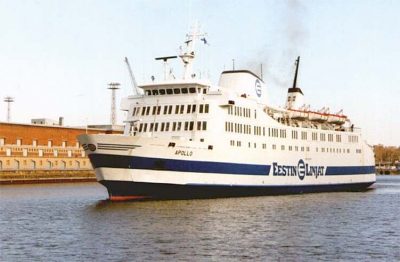
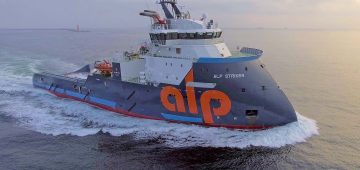



Comments
Sorry, comments are closed for this item